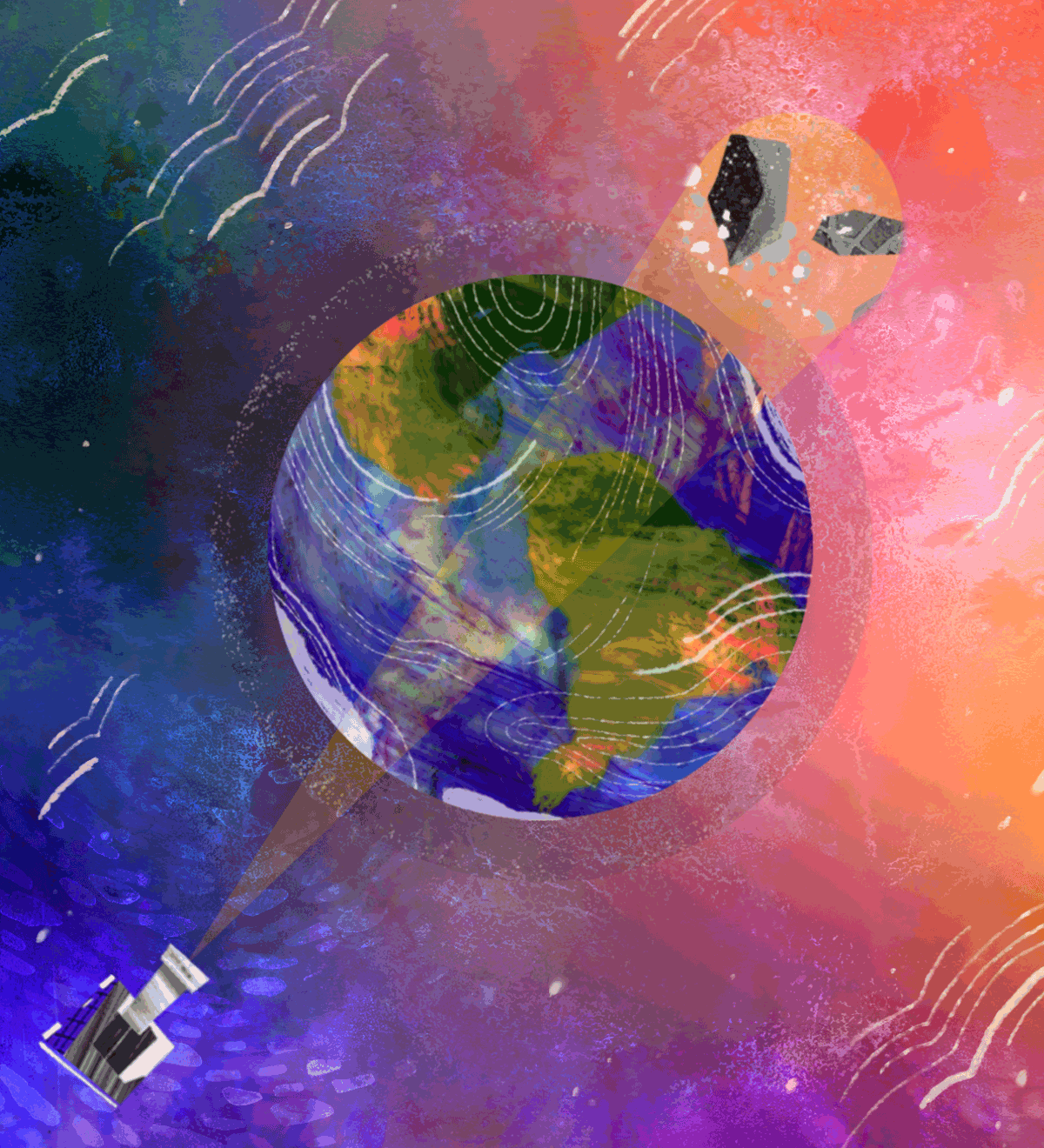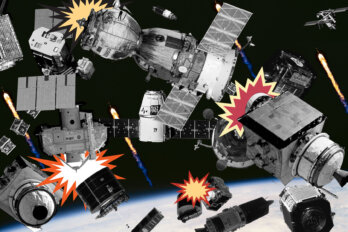More than 600 kilometres from Earth, a Canadian military satellite called Sapphire orbits the globe every ninety minutes or so. Roughly the size of a fully stocked beer fridge and about twice as heavy, it tracks other satellites and space objects between 6,000 and 40,000 kilometres above the Earth’s surface, sending back data that can warn operators when there’s a risk of a crash. As one of two Canadian chaperones in orbit, Sapphire’s task is monumental: a collision in space could take out satellite communications or GPS navigation, with potentially disastrous consequences.
Satellite technology is ubiquitous in modern life. Every bike ride or car trip that’s guided by GPS, every online bill paid from a cellphone, and every email to a friend in a remote area relies in some way on a satellite. There is no shortage of them in orbit: since 1957, when Sputnik I became the first satellite sent to space, about 9,600 more have been placed in Earth’s orbit. More than half of those satellites are still in space, but less than half of those remaining—about 2,300—are still functioning. The rest are junk. And, in space, junk is not just an environmental concern; it’s also a security hazard.
Technically referred to as orbital debris, space junk is any defunct human-made object remaining in space or reentering Earth’s atmosphere. Experts estimate that there are already millions of pieces of space junk in orbit, ranging from chips of paint and scraps of metal to used-up rocket stages and defunct satellites. The debris multiplies each time objects collide or a fuel leak causes a satellite or rocket to explode.
Eventually, this debris will fall back to Earth as atmospheric drag causes it to spiral into lower and lower orbits, a process that can take anywhere from weeks to millennia. (Atmospheric drag is similar to the force you feel when you put your hand out a car window as it’s moving, only much weaker because the density of air in space is so low.) Most debris will burn up as it reenters the atmosphere, but there are some exceptions. In 1978, a Soviet Union spy satellite powered by uranium failed in orbit, just months after it had launched, and fell back toward Earth. Instead of burning up on reentry, fragments—some of which were radioactive—scattered across the Canadian North. Just this past May, an almost twenty-tonne chunk of space junk from a recent rocket launch passed over Los Angeles and New York before crash landing in the Atlantic Ocean, off the coast of Mauritania. It was moving so fast that scientists couldn’t predict with certainty where it would land.
If it’s not raining down on Earth—a dispiriting extension of a planet already choked with trash—space junk forms an uncontrollable halo around the globe that threatens to destroy active satellites, shuttles and capsules that carry astronauts, and even the International Space Station. Errant scraps could cause millions of dollars of damage and wipe out satellite communications for search-and-rescue teams in the field, leave ships to drift off course, or interrupt Earth imaging vital to scientific research.
The stakes will only rise in the years ahead. Many private companies, including SpaceX and Telesat, an Ottawa-based firm, plan to launch thousands of additional satellites into space in the coming years, in part to provide internet services in rural areas. Those launches could lead to more potentially destructive junk: last summer, SpaceX revealed that three of the company’s first sixty Starlink satellites had failed, adding to the growing collection of space junk until they are removed from orbit. Sapphire alone can’t track everything. Without enough enforceable international rules to govern space activity or clean up debris, the very technology that makes our modern world possible could one day become its greatest threat.
The collisions that create orbital debris aren’t always accidental. In 2007, the Chinese government destroyed one of its own satellites to test weapons that target space assets. Though it was widely condemned, this type of test was not entirely new: both the US and Russia had conducted antisatellite weapons tests of their own, beginning in the late 1950s and 1960s. But the Chinese government’s 2007 exercise generated more orbital debris than any single previous human act. (Such testing hasn’t abated since: most recently, the US and Britain accused Russia of conducting an antisatellite weapons test in July.)
For space agencies and defence leaders around the world, the 2007 incident revealed the risk of unrestrained space activity. “I’ve often said that it was the best, worst thing that ever happened to space-debris tracking,” says Paul Maskell, a lieutenant colonel who worked on the Sapphire project and today serves as the senior staff officer to the Director General Space at the Department of National Defence. “It definitely woke up the world.”
The prevailing fear is that low Earth orbit could one day become unusable because of the Kessler Syndrome—a theory, proposed in 1978 by NASA scientist Donald J. Kessler, that the more orbital debris there is in circulation, the more likely bits of junk are to crash into other space objects in a cascade that creates still more debris. The risk was heightened in 2009, when a defunct Russian satellite, Cosmos 2251, collided with an operating US communications satellite. It was the first time two intact satellites had crashed accidentally. Years later, spacecraft were still having to manoeuvre to avoid the ensuing debris.
Around the world, space agencies and private companies have mobilized to beef up tracking capabilities and ultimately clean up low Earth orbit, which encompasses any ring around the planet up to an altitude of about 1,000 kilometres. While Sapphire is the focal point of the Canadian Space Surveillance System, the satellite isn’t entirely on its own. It contributes to the US Space Surveillance Network of radars, telescopes, and satellites that track more than 20,000 pieces of debris larger than ten centimetres. Sapphire’s key contribution is its ability to track objects in deep space unimpeded by the changes in weather that can blind ground-based systems. But, like its earthbound peers, its preventive powers are limited.
LeoLabs, a California-based company that uses a system of three ground-based radars to track more than 13,000 objects in space, recently launched an automated real-time collision-risk alert service for commercial satellite operators and governments. If defunct satellites or older models whose trajectories can’t be controlled remotely are at risk of crashing, there’s little such trackers can do aside from issuing a warning. Earlier this year, the company drew international media attention to the menace of space junk with its social media updates on a “particularly concerning” close call between two defunct satellites. Had they collided, the resulting debris field would have been considerable, says Mike Nicolls, one of the company’s founders and its chief technical officer. But, even as the satellites came closer and closer to a dramatic end, there was nothing to do but watch.
Two ways to help prevent the unmitigated proliferation of space junk are to extend the lifespan of satellites orbiting Earth and restrict the launch of new ones. MDA, the Canadian-owned space-tech firm that created both Sapphire and the famed Canadarm, is developing robotic solutions for both servicing satellites to keep them functioning longer and capturing and removing debris from low Earth orbit.
Cleaning up orbital debris is a “wickedly complicated” problem, says Maskell. Companies have to consider not only the technical challenge of trying to grab hold of an object that’s moving at a rate of seven or more kilometres per second but also the costs involved in removing even that one object. The European Space Agency’s ClearSpace-1 mission, which aims to launch, in 2025, what could be the first effort to remove a preselected piece of debris from orbit using robotic arms, is expected to cost around $184 million.
Perhaps a more daunting policy challenge than space cleanups, however, is preventing more reckless space activity in the first place. India tested its own antisatellite weapon just last year, creating potentially dangerous debris. Officials from India’s Ministry of External Affairs defended its actions, asserting that the test was conducted at lower altitudes to ensure any debris would fall back to Earth within weeks, but experts say the test threatened the International Space Station. “They put people’s lives at risk,” says Aaron Boley, co-director of the Outer Space Institute at the University of British Columbia, “and they demonstrated that they could not, in fact, control debris.” In space, no military exercise can really be contained if it generates a cloud of new junk. That’s why an international group of experts, who gathered earlier this year on a small BC island, have called for treaties to limit and eventually prohibit antisatellite weapons tests.
So far, countries and private companies face no real repercussions for littering in space. While international agreements, such as the UN’s 1967 Outer Space Treaty, lay out the basic legal framework for the use of space, there are no internationally binding rules to hold states or private companies accountable for the junk they leave behind. In its debris-mitigation guidelines, the Inter-Agency Space Debris Coordination Committee, an international governmental body of which the Canadian Space Agency is a member, recommends that all objects that pass through low Earth orbit be removed from space no more than twenty-five years after they stop operating. The United Nations Committee on the Peaceful Uses of Outer Space, which was established in 1959 “to govern the exploration and use of space for the benefit of all humanity,” recommends, among other things, that spacecraft be designed to limit the chances of collisions that create debris. Accordingly, many satellites have been built with propulsion capabilities that allow them to avoid crashes and, at the end of their missions, to de-orbit and return to Earth’s atmosphere more quickly.
The committee recently finalized a set of voluntary guidelines for the sustainable use of space, which underscore the importance of international cooperation for managing human activity in the cosmos. Experts, however, worry that an international framework that relies on the goodwill of each nation or private company operating in outer space may not be enough to temper a growing military reliance on satellite technology and the increasing privatization of space activity. A recent report by the Organisation for Economic Co-operation and Development found that compliance with debris-mitigation guidelines in low Earth orbit is “insufficient to stabilise the orbital environment.” “You need to have some basic rules for how you behave in space,” says Boley, “and we’re really lacking in what a lot of us would consider to be basic rules.”
Certain specimens of space junk may yet prove to retain some value. Alice Gorman, a space archeologist based at Flinders University, in Australia, wants policy makers to consider the cultural value of allowing certain objects to remain in space, provided they pose no immediate collision risks. Canada’s first satellite, the now defunct Alouette-1, may be one such artifact: with its launch, in 1962, Canada became the third country with a satellite in space. “The fact that Alouette-1 is still in orbit is a way for Canadian people to be connected to Earth orbit as a place,” she says.
Sapphire may one day join Alouette-1’s ranks. Ellyne Kinney, an engineer at MDA, is working on the next-generation Sapphire, which is being designed with a remote-controlled afterlife in mind. The new Sapphire, she says, will have propulsion capabilities, allowing it to swerve out of the way of other objects. That same system will eventually drive the satellite back toward Earth, and if all goes according to plan, the satellite will burn up in the atmosphere. As their missions draw to a close, satellites stationed farther from Earth may instead be propelled to a higher-altitude “graveyard” orbit, where defunct machines can be laid to rest out of the way of functioning satellites.
As for the current Sapphire? “Unfortunately, it does not have any propulsion on board,” Maskell says. So, at the end of its life, for the years before it naturally falls back toward Earth, Sapphire will become part of the debris problem it was created to help solve.





